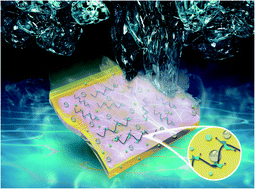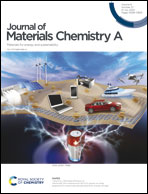An anti-freezing hydrogel based stretchable triboelectric nanogenerator for biomechanical energy harvesting at sub-zero temperature†
Abstract
Stretchable triboelectric nanogenerators (TENGs) have been made available for a large amplitude of human body movement as an effective wearable power source. However, the elasticity and performance of such a kind of device seriously decline in a harsh environment, especially below sub-zero temperature. In this work, an anti-freezing hydrogel was synthesized by one-step radical polymerization of acrylamide monomer in hydroxyethyl cellulose aqueous solution. After adding LiCl into the hydrogel, it can be cooled to temperatures as low as −69 °C without freezing. The hydroxyethyl cellulose not only enhances the mechanical properties as a physical crosslinking agent but also provides water retention properties. With a constant elongation of ∼150%, the anti-freezing hydrogel based TENG (AH-TENG) has been successfully demonstrated to harvest human biomechanical energy to drive wearable electronic devices, even in a harsh ice and snow environment. At a fixed frequency of 2.5 Hz, an AH-TENG with a 3 × 3 cm2 area achieved an output of 285 V, 15.5 μA, 90 nC and an instantaneous peak power density of 626 mW m−2, respectively. This work is anticipated to provide a promising approach for the advancement of flexible energy sources under harsh conditions.



 Please wait while we load your content...
Please wait while we load your content...